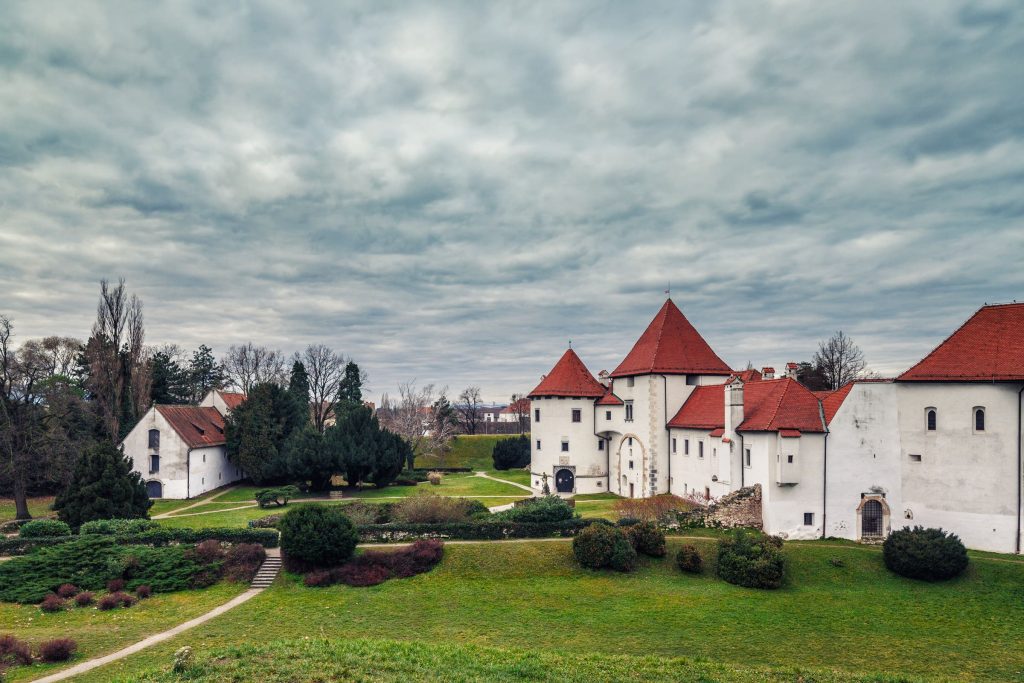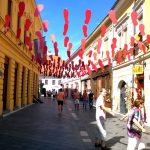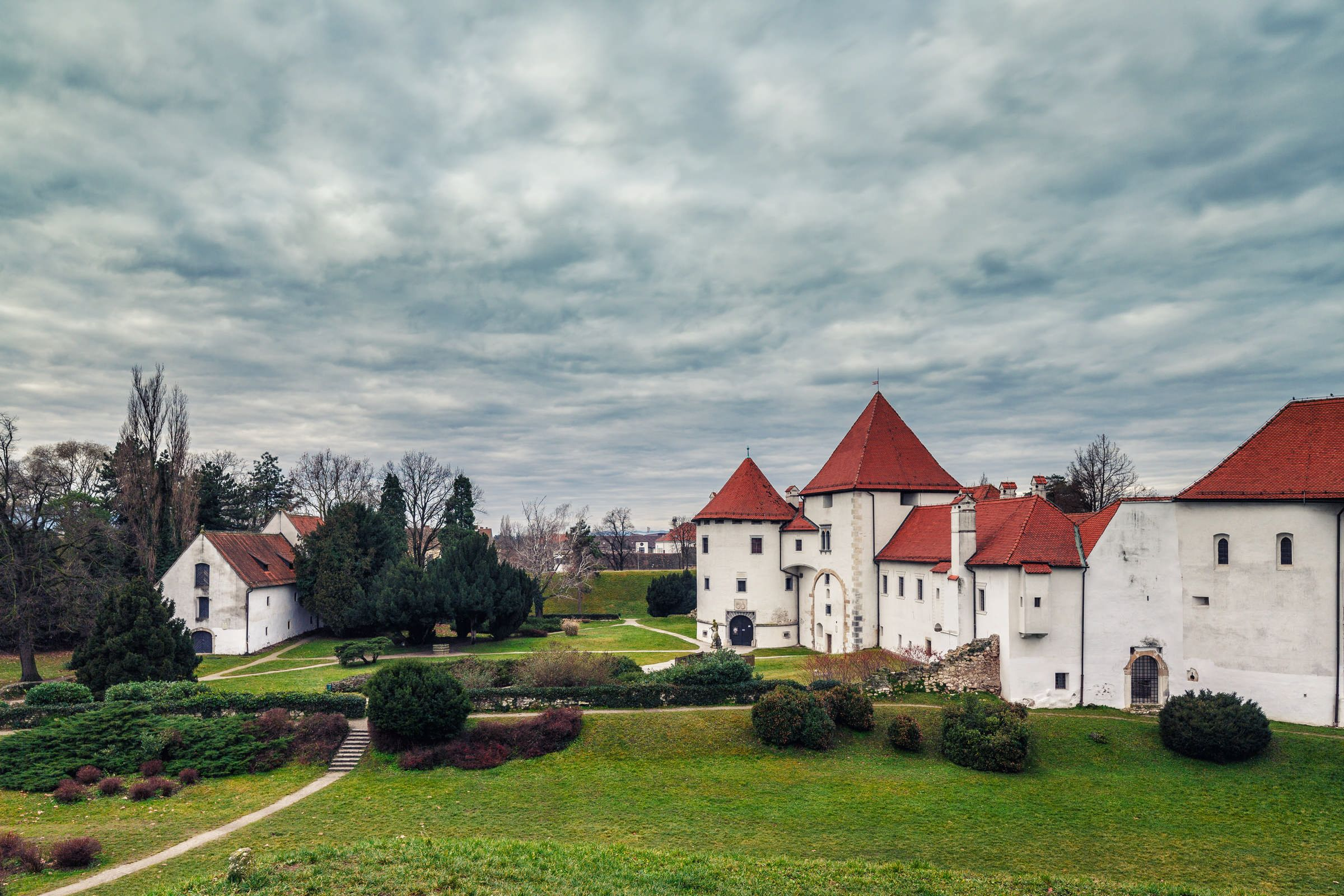
Continuing the TCN series, 25 Things to Know about Croatia, on June 20, 2016, a journey north to the gorgeous city of Varazdin. Although I am a Dalmatian boy at heart, I do admit I fell a little bit in love with this gorgeous city, a little off the beaten path, a LOT undiscovered, and yet very, VERY accessible.

1. Varazdin is the former capital of Croatia
The old town of Varazdin is simply GORGEOUS, and it was no surpise to learn that this stunning little old town was once the seat of power – the capital of all Croatia. In 1756, the Ban Francis Nadasdy chose Varaždin as his official residence, and Varazdin became the capital city. It hosted the Croatian Parliament and the Royal Croatian Council founded by Empress Maria Theresa. It was a period of great advancement for the city until a devastating fire ruined most of the old town, resulting in many institutions (and eventually the capital itself) relocating to Zagreb. How different the city’s fortunes would have been if it had statyed the capital city. Walking around the old town, one of the true treasures of this lovely country, I am rather glad that it was spared the growth and stress of a capital city.

The former seat of power can still be visited today.
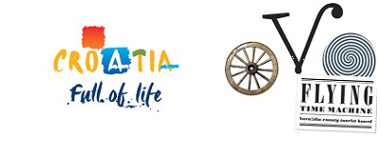
2. Varazdin was in the 2014 New York Times 52 places to visit

48. Varazdin, Croatia
Croatia’s architectural and musical gem lies inland.
Forget Croatia’s beloved coast: The inland city Varazdin is one of the country’s most picturesque and well-preserved areas. One hour north of Zagreb, this small metropolis of 50,000 has an immaculate cobblestoned town center and is stocked with Baroque churches and palaces like the Draskovic. The theme continues with an annual Baroque music festival, but that’s where it ends. Other music-themed festivals and concerts are decidedly modern and change from year to year: One, the Radar Festival, for contemporary stars, has drawn names such as Bob Dylan and Carlos Santana, and various other festivals throughout the year such as Spancir Fest, celebrated from the end of August to September, attract artists and musicians from around Europe. — SHIVANI VORA

3. The spectacular old town of Varazdin
In 2005, an application was made by the Ministry of Culture for Varazdin old town to be afforded UNESCO World Heritage Site status. Having seen some UNESCO heritage sites, Varazdin can count itself very unlucky that it did not succeed. You can read the official application in full here.
The old town is compact, pedestrianised, relaxed and a throw back in time to a fairtytale era. I could write a description of the numeous buildings of interest, but you can read the UNESCO link above or take a video tour below.

4. Varazdin Castle
There is no doubt about the top building to visit in the city – gorgeous Varazdin Castle, which sits picturesquely just off a main square in the centre, from where this picture was taken. According to Castles.info: This manor-house situated in the very centre of Croatian town Varaždin, used to seat feudal administration. This cultural monument of the highest category was built from 14th – 19th c., and has kept the appearance of a Renaissance fortification until the very present day. The fortification was built by the famous specialized engineer Domenico de Lalio and his associates. From the end of the 16th c. until 1925, Stari grad was owned by the counts of Erdödy, after which it came into the possession of the Varazdin municipality who then donated it to the city Museum. The last thorough renovation of Stari grad was undertaken from 1983 – 1989, when the new Cultural and Historic Department collection on permanent display was opened on the premises.
Established in 1925, the permanent exhibition located in the castle includes a number of both local and foreign items (about 30,000). The holdings have been classified into the following collections: Insignia; Guild Items; Paintings; Sculptures; Furniture; Ceramics; Glass; Costumes & Accessories; Photographs; Metals; Weapons; Cannons; Clocks & Watches; Historic Documents; Books, and memorial collections of Varazdin’s outstanding citizens Ivan Kukuljevic Sakcinski and Vatroslav Jagic. The collections bring testimony of cultural, economic, and political life in Varazdin and its surroundings.

5. The Book of Installation
One of the safely guarded treasures inside Varazdin County Hall is the Book of Installation, a book which has plenty of historical resonance, and one which has recorded the details of every major official meeting in the city for hundreds of years. I was apparently the first journalist invited to sign the book in 2014 on a trip to Varazdin with Touristar TV – I hope I left a suitably worthy comment.

6. A city of Baroque palaces
One does not have to walk around the centre for long to be struck by the architecture and the prevalence of Baroque palaces, each with their own individual style, beauty and history. More information at the tourist board, but the most important to check out are Town Hall, Bužan Palace, Drašković Palace, Eggersdorfer Palace, Erdődy Palace, Erdödy-Oršić Palace, Herzer Palace, Hinterholzer Palace, Janković Palace, Keglević Palace, Palace of Varazdin County,Palace of the Zagreb Kaptol, Patačić Palace, Patačić-Puttar Palace, Petković Palace, Prašinski-Sermage Palace and Pauline Mansion.

7. A city of angels
After nearly three decades of painting motifs of Baroque angels and artistic work under the banner of ‘Varazdin: the City where Angels Sleep’, local artist Zeljko Prstec organised a home for his work and that of others around the theme of the spiritual and angelic world. You will come across angels when walking around the city, but even if you missed them, stop by the Franciscan Church and take a peek of what they are doing in the ‘Andjelinjak’.

8. Varazdin’s guitar contribution to the world
Guitarist and composer Ivan Padovec (1880-1873) was born in Varaždin, Croatia. Juraj Karl Wisner Morgenstern passed his music theory knowledge on I. Padovec in Zagreb. From 1829 to 1837 Ivan Padovec played in Vienna. As one of the last European guitarists of his time, he perfomed with great success at concerts in his homeland and abroad (Vienna, Graz, Prague, Brno, Budapest, Frankfurt, Hannover, Hamburg, London, etc.).He wrote compositions for a guitar, mostly variations and fantasies on popular operatic themes. In his vocal works, solo songs with guitar or piano, he successfully approaches to the spirit of Croatian folk songs. And his lasting contribution to the world was the 10-string guitar, which you can see in the Varazdin Tourist Board office in the town centre. More info on Croatia.org

9. Baroque Evenings of Varazdin Festival
In keeping with its Baroque roots and culture, Varazdin is an extremely cultural city, where the arts thrive. An important part of the Baroque tradition is the annual Baroque Evenings Festival, when the churches and concerts venues of this city are filled with the music by J.S. Bach, G.F. Handel, A. Vivaldi, H. Purcell, D. Scarlatti and other masters. Over the course of the four decades the festival has played host to a range of eminent soloist and ensembles of baroque music. One of its special features are performances on authentic instruments. This celebration of music is accompanied by a number of other events which complement the cultural mission of the festival. And to provide the full image of that hedonistic period, the city also offers the aromas and flavours of its gastronomy. The 2016 festival will open on September 23, with Spain this year’s partner country, and you can see the whole programme here.

10. Spancirfest
But if there is one festival you should put in your diary for Varazdin, it would arguably be Spancirfest, a delightful festival when the streets truly come alive. In the words of the organisers:
The basic idea of the festival, named “Špancirfest”, is to make sure that during the period of the 10 days of the festival most visitors feel they belong to a particular cultural community that cultivates creative thinking, imagination and freedom of expression. “Špancirfest” gathers both professional and self-taught artists from all over the world. It takes place at the end of August and, as the first street festival in Croatia, is the most visited and most influential festival of this type in the country. It brings together musicians and bands, theatre companies, street performance companies, individual street performers and visual artists (multimedia, painting, product design etc.).
Take a peak at last year’s festival below, and plan your visit for Spancirfest 2016 from August 19-28. More information on the official website.

11. One of the oldest jukeboxes in Europe
Varazdin has a rich musical tradition, but there are some surprises with its musical heritage. An 18th century jukebox for example, which looks like a regular wardrobe on the outside, but turns into a musical hall when opened. Found in a nearby village three years ago, it is believed to be just one of three in the world, and the workmanship and music it performed left us all breathless. Housed at the town museum, the curator explained that there were eight songs pre-programmed and built into the jukebox, and having chosen number three, she then proceeded to wind it up and set the jukebox in motion. Have a listen to the jukebox in action in this Touristar video of Varazdin.


12. The welcoming organ grinder of Varazdin
And no musical city would be complete with its own official organ grinder. A very popular feature on the Varazdin cultural scene is this man, the official organ grinder of Varazdin, bringing a dash of charm, style and refreshing music to every occasion. Check out the Touristar video above for a sample of the tunes. Varazdin is that kind of place where you almost expect an official organ grinder. Truly a fairytale city.
13. A city of youth and innovation
But also a city of youth and innovation, something that one feels on the streets. For Varazdin is a major university town, and I for one cannot imagine a more relaxed place to complete one’s studies and be inspired by a city’s heritage and nature. Many graduates stay on in the city which has become their temporary home, for there are jobs to be had. Varazdin is one of the most important IT hubs in Croatia, and Total Croatia News, for example, would be much the poorer without the efficiency of the web services provided to us from Varazdin.

14. Purgari – the Varazdin Civil Guard
As befits the former capital of Croatia, Varaždin has for the past two and a half centuries been watched over by the Varaždin Civil Guard. They were recognised by the Austrian Empress Maria Theresa in a statute of 1750. It is an honour to be a member of the Varaždin Civil Guard. A member can only be a man born in Varaždin who is proud of its honour and irreproachably honest. In their blue grenadier uniforms and tall fur hats, these handsome ‘Purgari’ play a part in many secular and religious events. However, the most attractive aspect of the ‘Purgari’ is the ceremonial changing of the guard, which is staged most Saturdays in front of the Varaždin City Hall. The company had its own orchestra and flag, and the ‘Kume’ (‘Godmothers’) of the flags were prominent figures from the ranks of high nobility or the royal house. Therefore, the ‘Kuma’ of the last Purgar’s flag from 1998 was Francesca von Habsburg. From 15th May to the 15th October, the Guard parade takes place every Saturday from 11.00 a.m. to 12.00 p.m. in front of the City Hall. Watch them in action below.

15. The Varazdin cabbage mafia
And now we come to the important stuff. Cabbage. You will hear a lot about cabbage in Varazdin, so much so that Varazdin has its own protected type of cabbage. Not only that, it also has its cabbage mafia. According to 10hrcak website:
Cabbage “Varaždinsko zelje” (Brassica oleracea var. capitata f. alba) is an authentic vegetable variety of Varaždin cabbage which is, in Varaždin region, produced in large quantities for commercial purposes. Written historical traces of its cultivation date from second half of the 18th century, and are cited today in numerous journals and scientific papers. Specific qualitative characteristics of Varaždin cabbage, owing to the soil properties, relief, climate and the influence of the human factors in production, are obtained by many years of method adjustments and the application of the acquired knowledge in production. So as to protect the authenticity, Varaždin cabbage is produced in the traditional way, in a limited geographical area of the Varaždin County under authenticity, origin and quality control. Varaždin cabbage represents an authentic Croatian product based on the authentic Croatian variety symbolizing the maintenance of its own agrobiodiversity.
And then my big discovery. There is only one woman in the world who is licenced to sell these special Varazdin cabbage seeds. During the 2014 Zeljarijada, where a world record sarma (cabbage leaves stuffed with mince) was attempted, I was introduced to a lovely lady called Marija, who controlled the Varazdin cabbage scene. A lovely lady, and after three days in the region, I felt qualified to write the book, 101 Things to Do with Varazdin Cabbage. Some great dishes.

16. Unique metal art
One thing I have learned in my time in Croatia is that there is a story behind every door, and in every courtyard. And so too in Varazdin. Strolling around a rather deligthful part of the old town, I was directed into a courtyard, where words failed me, as I was introduced to Miroslav Prikratki and his rather curious obsession – metal. A lovely man, he gave me the most fascinating tour of his courtyard and then every room of his house, including the basement, with metal souvenirs of all shapes, themes and sizes. I have never seen anything like it, and if you are in the old town, I do encourage you to visit. Ask for more details at the local tourist board.

17. Queen Sisi and the courtyards of Varazdin
And speaking of the secrets of courtyards, that it one of the things I enjoyed most about Varazdin, the sense of discovery. The old town, never busy – despite the fact it more than matches Croatia’s more famous picuturesque cities for its beauty – has several little escape routes if you want a little more peace and quiet. And there is history to be discovered in these places, including the story of Queen Sisi, a royal beauty who was the Lady Diana of her day, who met a similar tragic fate. Her legacy is reflected in the picture above, a coffee named in her honour, complete with a generous helping of pear rakija to kick start the day.

18. Varazdin cemetery
Croatia is well-known for its cemeteries, which often take pride of place in prime locations, and many prime spots on the Adriatic coast which would have tourist developers salivating are reserved for the recently (and not so recently) departed. Varazdin also has a spectacular cemetery worth visiting. Created in the early 20th century by planting of thuja, cut and formed into screens and arcades like the French park of Versailles, Varazdin Cemetery is a magnificent monument of garden architecture.

19. Hotel Park Boutique Hotel
No tourist destination is complete without a quality hotel, and this is something that Varazdin has been sadly lacking until recently. The opening of Hotel Park Boutique in the centre of the city, on the edge of a park which truly immerses one in the tranquil nature in the heart of the city, has been a game changer. Now businessmen looking for quality accommodation no longer need to return to Zagreb, tourists looking for a little extra comfort have one more reason to stay. For a closer look at Hotel Park Boutique, check out TCN’s recent visit.

20. The perfect weekend destination
It really is. Heritage, spectacular buildings in the old town, a totally safe environment for families, whose parents can watch their little ones play on the numerous squares while they relax over a coffee or something stronger. And despite being off the main tourist route, it is surprisingly accessible from several key population centres – one hour by car from Zagreb, 2 hours 20 from Graz, 2 hours 45 from Ljubljana and three hours from Budapest.

21. Varazdin Klipic
Since the 18th century, a recognisable odor came out of the Grand hotel Novak in the heart of the royal city of Varaždin, on the corners of today’s Kukuljevićeva and Šenoina street – the smell of the Varaždin roll. Three hundred years ago, a recipe was created, the same one we share with you today, the recipe to make a unique and landmark culinary product.
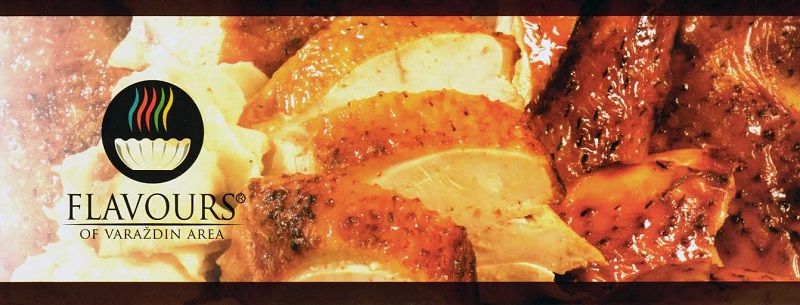
22. Gastronomy
Which brings us to food. And cabbage. One thing is certain when you visit Varazdin – you won’t go home hungry. A gourmet overview from the tourist board:
“Hedonism is associated with the sumptuous Baroque age, which was a conspicuous part of Varaždin’s history when the glory of its dishes reached the French court. This tradition of rich cuisine, based on traditional dishes and foodstuffs grown domestically nearby, is cultivated in Varaždin’s restaurants still today. Traditional Varaždin cuisine was influenced by Austria and Hungary, but during historical migrations other modifications and innovations that enriched it were introduced. Traditional dishes from the Varaždin area generally consist of a few simple ingredients, of which the most commonly used is wheat and corn flour in the famous Varaždin ‘klipič’, ‘mlinci’, ‘štrukli’ and ‘zlevanka’. Game has an important part to play in the area’s cuisine, as this is one of the oldest areas in Europe where game-keeping has taken place. In Varaždin’s restaurants it should be mandatory to taste ‘mlinci’, ‘klipič’, spicy game dishes, poultry dishes with vegetables, homemade puff pastry cakes and a variety of rolls.”

23. World of insects
If you are an insect, Varazdin is a great place to retire, and if you are interested in insects, the World of Insects exhibition is a must. In the words fo Loveit.hr:
The Palace now houses an Entomological Collection which was donated by Prof. Franjo Košćec, a local teacher. This collection was turned into a permanent collection entitled the ‘World of Insects’, renovated in the 1990’s and is considered to be one of the finest collections of its kind in Europe. It ranges through several tropes: night time, woodland, woods and meadows, freshwater, the tide line and in the soil. The specimens were exposed to entomological preparations, and these alongside the prepared slides of vertebrae, herbal plant samples, magnified insect models, photographs and various other items from the legacy left to us by Prof. Košćec. Also included in the collection are tools used to process specimens which were designed and made by Prof. Košćec. The Permanent Collection also houses collections from other naturalists dating from the 19th and 20th Centuries, and there is also a replica of Prof. Košćec’s work room.

24. Shopping as It Once Was – the local market
One of the undoubted highlights of Varazdin for me was a visit to the local market. Colourful, local, fresh. So much of what we have forgotten back in the ‘civilised’ countries of Western Europe. Just visiting the market was an inspiration, a little more so when I learned there was a recently opened restaurant close by, which only serves food from ingredients sources at the market. With the market produce coming from local farmers, it doesn’t get much better than that…
Staying with the local theme, do check out the local craftsmen’s work. Craftsmen are an indispensible part of the economic and cultural traditions of Varazdin. The inevitable course of history is difficult to stop, and therefore Varazdin has not been City of craftsmen for some time. Some are still active and can be found in the newest and smallest of Varazdin’s town squares; the Traditional Crafts Square. In the shadow of the Ursulinski Church tower, these hardworking people maintain the traditions of hand crafted items that are still used today, and also make items that have sentimental value for the people of the town and area.

25. Varteks
From the city’s football club to its best known business, there is no style like Varteks, the biggest show in town:
“Varteks is a leading Croatian fashion company with almost 100-year old tradition. Its 1,950 employees place it amongst the biggest employers in northwestern Croatia. Next to its own brands Di Caprio and Varteks at more than thirty stores throughout Croatia, the represented brands Seventy, Navigare, Camel, Orljava, Galko, Samsonite, Lisca, Modea, Polzela, Croata, San Peter… are on offer as well. Apart from covering the domestic market, the company also has an exceptionally active export strategy and about forty percent of sales revenues is generated on foreign markets. Over the past few years, Varteks has been undergoing restructuring, with a priority on the adaptation to market conditions as well as on gaining a competitive advantage and realizing positive business results in future.” Learn more on their official website.
And we leave you with some video impressions of this fabulous city.
https://www.youtube.com/watch?v=bAZ-Xhqes_A
Photo credits Varazdin Tourist Board and Touristar TV.

